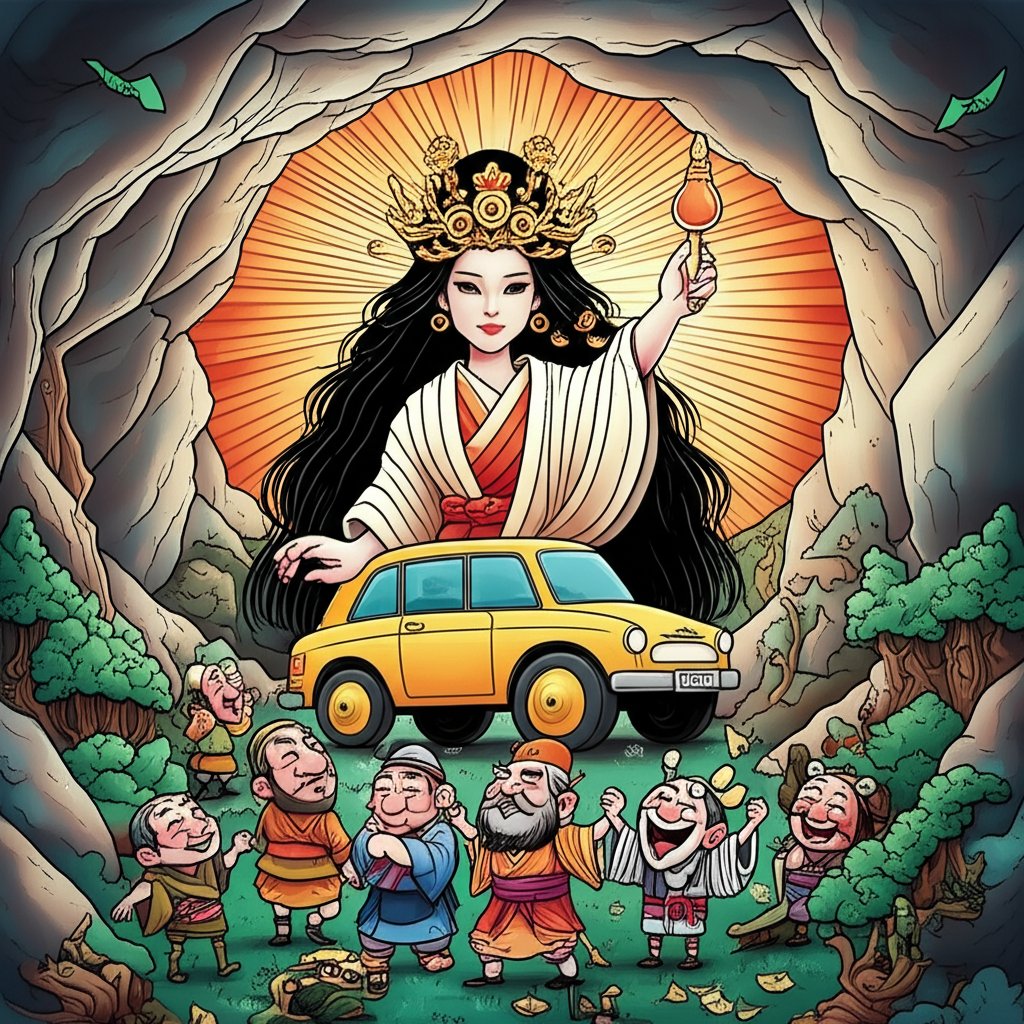
Introduction:
This story hails from the rich tapestry of Japanese mythology, a collection of tales woven over centuries by the people of the Japanese archipelago. These narratives, passed down through generations, served as a framework for understanding the world, explaining natural phenomena, and providing moral guidance. This is a traditional story, a window into the beliefs and imaginings of ancient Japanese people. It is not presented as a factual account, but rather as a fascinating glimpse into a rich cultural heritage.
Origins and Cultural Background:
The myth of Amaterasu and her cave originates in the pre-Buddhist and pre-Shinto period of Japanese history, a time when animism and ancestor worship were central to the people’s spiritual life. The people of this era lived in a world where the forces of nature – the sun, the moon, the wind, the sea – were believed to be imbued with divine spirits, or kami. Their society was structured around agricultural life, with rice cultivation being the cornerstone of their economy and sustenance. Rituals and ceremonies, often conducted by shamans or priests, were crucial for ensuring bountiful harvests, warding off misfortune, and maintaining harmony within the community and with the natural world. The world was seen as a dynamic interplay of light and dark, good and evil, and the kami were believed to constantly interact, influencing the fortunes of humanity. The sun, represented by Amaterasu, was of paramount importance, providing light, warmth, and the life-giving energy that sustained their crops.
Character / Creature Description:
The central figure of this myth is Amaterasu Omikami, the radiant sun goddess. In depictions, she is often portrayed as a beautiful and powerful figure, emanating light and warmth. She is the progenitor of the imperial line, the ancestor from whom the Japanese emperors are believed to descend. Amaterasu embodies the life-giving properties of the sun – its warmth, its light, and its ability to nourish the world. She is associated with purity, benevolence, and order. Her brother, Susanoo-no-Mikoto, the storm god, is a contrasting figure, often depicted as wild, destructive, and tempestuous. His actions serve as a foil to Amaterasu’s serenity, highlighting the interplay of opposing forces in the cosmos. Other important characters include the numerous other kami, deities representing various natural forces, who play supporting roles in the unfolding drama.
Main Story / Narrative Retelling:
In the celestial realm of Takamagahara, the Plain of High Heaven, resided Amaterasu, the glorious sun goddess, reigning over the world with her gentle light. But even in paradise, discord could brew. Her brother, Susanoo-no-Mikoto, the god of storms, was a turbulent and unruly spirit. He wreaked havoc, destroying rice fields, defiling sacred grounds, and generally causing chaos. Driven to despair by his disruptive behavior, Amaterasu found herself increasingly saddened.
One day, Susanoo, in a fit of rage and grief over being exiled from Takamagahara, committed an act that shattered Amaterasu’s tranquility. He flayed a piebald pony, a sacred animal, and flung it into the sacred weaving hall where Amaterasu’s attendants were working. Terrified by the sight, one of the attendants was killed in the chaos.
Overwhelmed by grief and fear, Amaterasu retreated. She sought refuge in a cave, known as the Heavenly Rock Cave, and sealed herself inside, plunging the world into darkness. The sun vanished. The world, deprived of its life-giving warmth and light, fell into chaos. The crops withered, the animals ceased to thrive, and the kami themselves fell into despair.
Desperate to lure Amaterasu out, the other kami convened. They devised a plan. They gathered at the mouth of the cave, where they set about performing a variety of acts, hoping to entice the sun goddess out of her hiding place. They hung a mirror on a tree, the Yata no Kagami, reflecting the light back into the world. They built a large bonfire, and they crafted a magnificent jewel, the Yasaka no Magatama.
The goddess of mirth, Ame-no-Uzume, began a boisterous dance. She clapped her hands, stamped her feet, and even bared her breasts, an act of such unexpected and uninhibited joy that the other kami roared with laughter. Amaterasu, hearing the commotion and curious as to why the world was filled with such merriment, peeked out from the cave.
Peeking out of the cave, she saw her own radiant reflection in the mirror, which shone with a light that surpassed even her own. Intrigued, she slowly emerged, and as she did so, the kami quickly grabbed her and pulled her out of the cave. The light returned to the world. The joy of Amaterasu’s return was echoed by the world, and life was restored. Susanoo, for his actions, was banished to the underworld.
Symbolism and Meaning:
This myth is rich in symbolism. Amaterasu, as the sun goddess, represents light, life, and the source of all things good. Her retreat into the cave symbolizes the withdrawal of these vital forces, leading to a period of darkness, chaos, and desolation. Susanoo, the storm god, embodies the destructive forces of nature and the potential for chaos. The actions of the other kami, particularly Ame-no-Uzume’s dance, represent the power of joy, celebration, and ingenuity in overcoming despair. The mirror, representing the goddess’s reflection, highlights the importance of self-awareness and the recognition of one’s own power. The entire narrative can be interpreted as a metaphor for the cyclical nature of life, death, and rebirth, the interplay of light and darkness, and the constant struggle between order and chaos. The story could also have been interpreted as a lesson about the importance of harmony and cooperation, emphasizing that even the most powerful beings can be vulnerable and require the support of others.
Modern Perspective:
The myth of Amaterasu and her cave continues to resonate in modern Japanese culture and beyond. It is a popular subject in literature, art, and film. The tale has inspired numerous anime and manga series, video games, and works of art, offering interpretations and re-imaginings of the story. It is frequently referenced in cultural studies and anthropology, providing insights into the beliefs and values of ancient Japan. The themes of light versus darkness, good versus evil, and the importance of perseverance continue to find a place in contemporary storytelling. The tale also serves as a potent reminder of the power of storytelling to preserve cultural heritage.
Conclusion:
The myth of Amaterasu and her cave is a captivating tale, a testament to the power of imagination and the enduring appeal of storytelling. It offers a glimpse into the worldview of ancient Japanese people, providing insight into their understanding of the natural world, their values, and their beliefs about the divine. This is a story rooted in cultural heritage, a tradition passed down through generations.
We, as Muslims, recognize that Allah is the one and only true Creator and Sustainer of the universe, the source of all light and life. The stories of other cultures, like the tale of Amaterasu, can be appreciated as a reflection of human creativity, imagination, and the universal quest for meaning. They can inspire us to reflect on our own cultural heritage and to appreciate the rich tapestry of human storytelling traditions.





